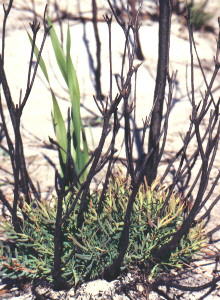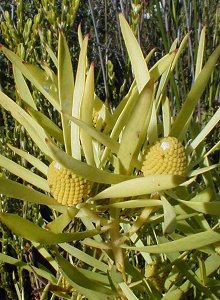
Home
Mission
Overview of Project
Project Staff
Sponsors
Achievements
Checking, Illustrations
Upcoming Activities
Id and Species Lists
Protea Information
Protea Gallery
Growing Proteas
Interim Dist. Maps
Publications
Afrikaanse Inligting
![]()
Single Stemmed Resprouters
When I first came across single-stemmed Common Sunshine Conebush - Leucadendron salignum it nearly cured me of atlassing! They ought to know they resprout, but this population on the way to Hermanus produced well-trunked trees up to 2 m tall. Two years later we came across more single-stemmed Ld sgnm on the north side of the Riviersonderend Mts. On inspection, these seemed to have developed from normal resprouters, perhaps as a result of very dry conditions in the area. Two of the trunks that I poked around had rootstocks underneath. One or two of the plants even had a couple of dead sprouts as well as the single bigger surviving sprout. Do you reckon the single stemmedness would always be secondary - a reaction of old stressed plants? Or do the plants start single stemmed and go on that way? Is there a finite number of 'budding points' on the rootstock?
Ruth Smart, Wynberg

 Most reprouting plants have
one fire cycle from germination to establishment. During that time they have to ensure
that they will survive the next fire. To this end they invest their resources in forming
an underground bole. Many plants don’t even flower during their first fire cycle,
putting everything into surviving the first fire. However, as you noticed, not all plants
read the book.
Most reprouting plants have
one fire cycle from germination to establishment. During that time they have to ensure
that they will survive the next fire. To this end they invest their resources in forming
an underground bole. Many plants don’t even flower during their first fire cycle,
putting everything into surviving the first fire. However, as you noticed, not all plants
read the book.
Some species (e.g. Leucospermum tomentosum west of Darling) produce the odd plant that is erect, single-stemmed and doesn’t show any evidence of wanting to resprout. This may be a recessive gene, or a throwback – it certainly does not seem to have become established in the population – fewer than 1 in 200 plants follow this strategy. However, this is the exception among proteas (whereas in Erica several species have odd plants that don’t resprout. And some species have populations some of which resprout and some of which don’t). Plants that don’t produce seeds and don’t sufficiently invest in surviving fires are genetic dead ends.
Where plants do not burn due to lack of fire, a single stem often dominates and other stems die back. However, these surviving stems usually have little clusters of green leaves at the epicormic buds near their bases. And the dead stems are usually easily visible. These plants may reach great size – I have seen 4.5 m tall Leucadendron spissifolium spissifolium at Pakhuis Pass. After a fire the plants are burned back to size and will produce the new growth from surviving wood. Only Pr nitida has succeeding in regularly producing single-stemmed trees in Fynbos.
Given the above, I would venture that the Ld salignum from near Hermanus is a wrong identification and probably is Leucadendron xanthoconus or Leucadendron salicifolium.
Tony Rebelo
Back PAN 49